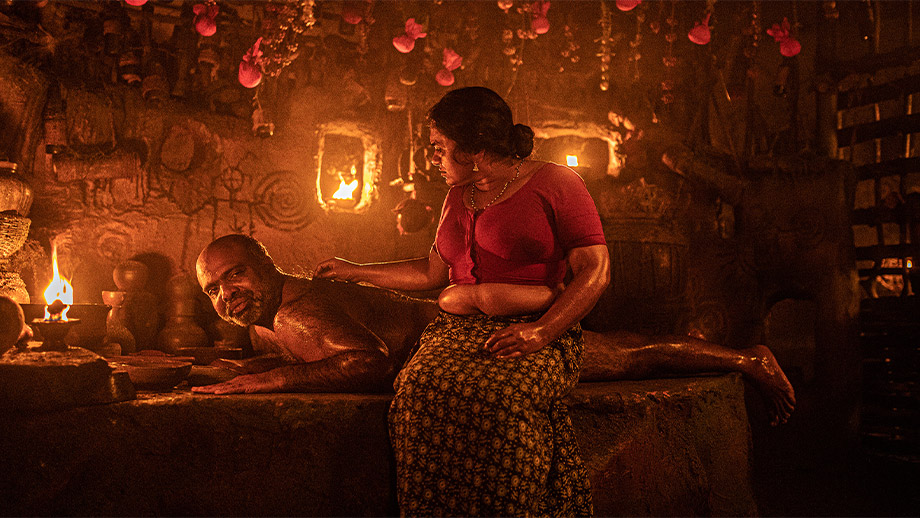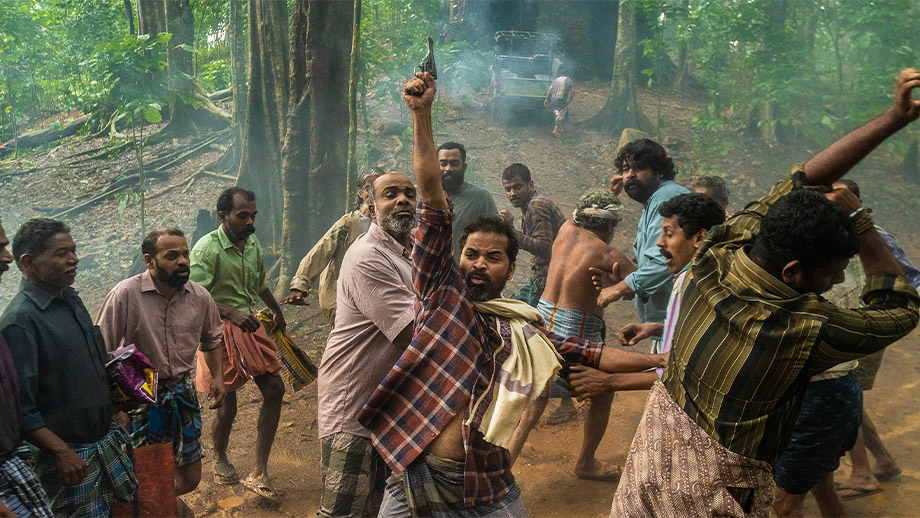Spoiler alert: This review contains mild spoilers and is based on the OTT version of the film
Based on a story by Vinoy Thomas, and written for the screen by S Hareesh, director Lijo Jose Pellissery’s Churuli opens with an aphorism about a mouseling trapped before a cat with enormous eyes. It imagines how different Gods would respond, had they been watching over. A gentle God would ensure softness in the paw strikes of the cat, whereas a patient God would take a few hours to finish. A kind God would promise life to the mouseling, the possibility of hope, several times. But the God of time is in no hurry to put an end to this predicament.
Soon after, an animated, anecdotal story of a Monk (belonging to a dominant caste) unfolds on screen, narrated by a woman. He sets out to tame the phantom in the forest who misleads travelers, and picks up an intriguing ball like object on the way. The ball, revealing itself to be an ant eater, playfully leads him through different pathways, eventually having him go in circles for eternity.
The plot is set into motion with two policemen disguised as Antony (Chemban Vinod Jose) and Shajivan ( Vinay Forrt) venturing into the dense hamlet of Churuli on the lookout for a fugitive. They board a jeep, traversing thickly forested, treacherous terrains and get stuck at a log bridge, the link between Churuli and the rest of the world. They manage to cross it after numerous attempts and introduce themselves as labourers looking for work at a rubber plantation, the owner of which they are told is away. The duo is then taken in by a local toddy shop owner, who lets them stay around.
The spiral, a curve that widens into a series of winding circles is perhaps one of the most naturally and abundantly occurring patterns in nature. Churuli uses the spiral motifs generously, as if to depict that the map of the village of Churuli is an infinite, winding spiral, reminiscent of the loop the Monk gets trapped in. From the onset, Churuli is established as a place removed from the society as we know it. The inhabitants display a wild sense of unreliability and are united when it comes to keeping their land protected. Shajivan is instantly sucked into the eeriness of Churuli. He feels that he may already have been in Churuli longer than he can tell.
The duo maintain their clandestine act, secretly trying to extract information about Joy, the criminal they have come in search of. But the serpentine landscape of Churuli with its lores, lawlessness and primal liberties has something else in store for them. The film, which shuttles between genres, seems to tell us that we are all caught in a simulation. But is this loop merely metaphysical, or is it a political metaphor for the primitive within the human?
A primal, masculine labyrinth
Lijo Jose Pellissery’s thematic engagement with the animal within the human has surfaced prominently since Angamaly Diaries. Jallikettu interpreted it in more concrete terms, and Churuli seems like yet another spin on the same.
Set in the sub-genre of folk horror, Churuli’s world building is primal, illusive and masculine – a labyrinth that leads you astray, while attempting to bring you closer to your evolutionary essence. Antony and Shajivan, two gatekeepers of law, enter Churuli with a sense of justice and the belief that their mission contributes to the maintenance of social order. Churuli is a place where there is no policing system, governance or laws. The characters have interchangeable names, and spew expletives like the most natural thing.
If we examine the politics of the plot, Churuli taps into the conflict between the primal human spirit with our need for civilization against the omnipresent, inescapable indifference of time itself – perhaps the most fatalistic essence of the survival loop that human beings are doomed to be perpetually caught in. The most fundamental idea the film anchors on is whether or not we are inherently designed to live in a social structure that mandates the binary order of the good and the bad. If we were to live in a society that did not ask to us have moral boundaries, who would we be? Perhaps, the inhabitants of Churuli.
The women in Churuli do hold some power, standing up to the men in some situations, but they are always labouring, serving, healing or covering up for the men. The house of Pengal (Geethi Sangeetha) is where Antony’s inner self, alien to conditioned morality is birthed. Even though Pengal assumes agency over her sexual desires, her function in the plot is still feminine – birthing and healing. Having women utter profanities just like men does not make the conscience of a narrative gender equal. The question is how much decisive power women hold in it

By positioning Churuli as a place away from reality, buried deep within the world as we know it, the characters seem like people who have achieved a sense of autonomy that comes with the acceptance of their animalistic selves. The use of symbols from mythology and religion, sprinkled with the mysteries of black magic, make Churuli’s lucid premise visually plausible. The alien apparitions that occur occasionally, the Theechamundi (fire ball) that travels back and forth, and probable time machine found in one of the inhabitant’s house, all seem extremely natural in the universe built by Madhu Neelakandhan’s visual sorcery, backed by Sreerag Saji’s background music and Renganaath Ravee’s sound design.
But the obsession of the plot with turning everything into an anecdote shrouds the narrative with a heightened sense of wonder. If we strip Churuli off its cinematic and executional grandeur, the question we must ask is – does this mean that the primal instinct in us cannot ever be streamlined? If a world like Churuli is where we truly belong, what about those among us who are more vulnerable than the others? Does our possibility for a conscience as a species have no meaning at all?
Though it is easy to lose track of the thematic standpoint of Churuli in the midst of its metaphysics, it is important to analyse where the film stands with respect to its extrapolation of Lijo Jose’s seemingly favourite ‘man himself is the biggest beast’ theme, and how women and children fit into this context.

The women in Churuli do hold some power, standing up to the men in some situations, but they are always labouring, serving, healing or covering up for the men. The house of Pengal (Geethi Sangeetha) is where Antony’s inner self, alien to conditioned morality is birthed. Even though Pengal assumes agency over her sexual desires, her function in the plot is still feminine – birthing and healing. Having women utter profanities just like men does not make the conscience of a narrative gender equal. The question is how much decisive power women hold in it.
Even among the men of Churuli, social stature is determined by the capacity for conquest, which is a hyper masculine positioning of physical dominance. There is mention of pedophilia and children may not entirely be safe in this set up.
Shajivan experiences fragmented dejavus of having been at many places in Churuli before. This is perhaps indicative of the collective memory of human beings as a species, the innate understanding that we were all once the same kind of animals. But the ‘we’ here is exclusive of women. The conscience of Churuli, both the land and the film are masculine, with little room for the possibility of building an alternate world that is kinder and egalitarian.
Also read: PUBG And The Glorification Of A Hyper-Toxic-Masculinity
Engaging with a hyper masculine cinematic universe as a woman
Watching Churuli as a woman is quite an alienating experience, because the women on screen are for one scarce, and on the edge of being thrust into violence. Most of the expletives used also refer to the female genitals in a derogatory manner. While discussing the appropriateness of cuss words in the film, the larger debate must also be about why genitals of any sex, or the caste locations of people double up as foul language in the first place. The narrative could have subverted the use of expletives by using different words, and this is possible because anything is possible in the world of Churuli. But the decision not to is conspicuous and disturbing.
Patriarchal morality considers nudity as obscene, and female nudity, even more so. In a particular scene when one of the characters speaks about his reluctance to go looking for a certain someone in his house because only a woman would be there at the moment, he is asked a question, “Will the woman squish you between her thighs?” The fact that the men of Churuli immediately associate a woman, any woman, with what lies in between her legs be it to describe them or to abuse other men is perhaps a reflection of the male gaze on women in real life. But to be privy to a cinematic universe that is unwavering in its repetitive reliance on this gaze is frustrating.
One could argue that in a chaotic, lawless land, this is how men behave – they hunt, conquer, dominate and fornicate at will. But that in itself is proof of the fact that a world like Churuli which romaticises the anthropomorphic chimpanzee in us cannot be stomached without dread by those who would be most affected by its violence – women.
The civil society we are trying to build may not be the best scenario which addresses all our needs as human beings. The social order we consider acceptable draws from popular morality, and harbours in its heart many questionable double standards. Art need not be puritan in its conceptualisation or critique of these double standards. But the alternative to the misgivings of one kind of social order cannot be the embracing of disorder itself. Churuli may not be asking us to, but its mystification of this netherworld is quite concerning

Both Jallikettu and Churuli play with the wild within, and though neither seem to idealise or embrace the resultant chaos, they also do not remotely mention the possibility of an alternative. Churuli seems to be comfortable in its acceptance of the age old ‘men will be men’ narrative. The masculine conscience can of course, take this lightly and be comfortable with passing it off as an exploration of the grey within us, or cinematic liberty, because even if this fantasy were to become a reality, it would still advantage men.
But for women, children and members of other marginalised gender and social locations, the normalisation of this narrative is deeply threatening. The modern society has been in a constant attempt to negotiate parity, and diffuse the hierarchical use of power. In that context, to obsess over the untamed within us, and to perhaps suggest that eventually everyone gets sucked into their own whirlpool of chaos without redemption, is problematic.
Normalising the primal want for control, domination and coitus in man as his inescapable destiny does push us to scrutinise ourselves, but it also in a way, posits this primal state as one that cannot or perhaps need not be transformed into something more suited for respectful coexistence. Towards the climax, as Antony and Shajivan try to exit Churuli with Joy, they are unable to find the log bridge that they traversed while entering into the village. Shajivan is almost relieved, because he always felt he belonged in Churuli.

Churuli is an anarchic landscape that is tempting, and would make most men feel they belong in its winding spiral. It is liberating, limitless, and extremely gratifying. Even as it attempts to critique the vulgarities of the masculine ego, it does find relief in not having to put a leash on any emotion, in a world that lets one be, irrespective of the damage. A character says, “You can hunt, kill and fornicate without care, If this is not paradise, what is?” Whose paradise is this, and what about the women and the children who become easy targets? No matter how magnetic the core of Chruruli is, women and children will only find a place in it after the men.
The civil society we are trying to build may not be the best scenario which addresses all our needs as human beings. The social order we consider acceptable draws from popular morality, and harbours in its heart many questionable double standards. Art need not be puritan in its conceptualisation or critique of these double standards. But the alternative to the misgivings of one kind of social order cannot be the embracing of disorder itself. Churuli may not be asking us to, but its mystification of this netherworld is quite concerning.
Churuli is the untamed within, the phantom that misleads our waking conscience into the abyss of the primordial in us. The film deserves to be watched for its cinematic vocabulary and fascinating world building. But we must also pause and see through the problems of normalising primitive, masculine temptations, and decide for ourselves if we must preserve the log bridge or not. As a woman, I sure hope we do.
Also read: Why We Need To Reject Toxic Masculinity For Better Mental Health
About the author(s)
Sukanya is a lawyer-turned-journalist with experience in writing, editing, development communication, and advertising. She holds a graduation in law, a post-graduation in philosophy, and a post-graduate diploma in print journalism. She is also a published poet and was awarded the All India Poetry Prize in 2015. Her journalistic work is deeply focused on gender and intersectionalities, and they appear in Feminism In India, True Copy Think, and The News Minute.





Makes sense. Good review